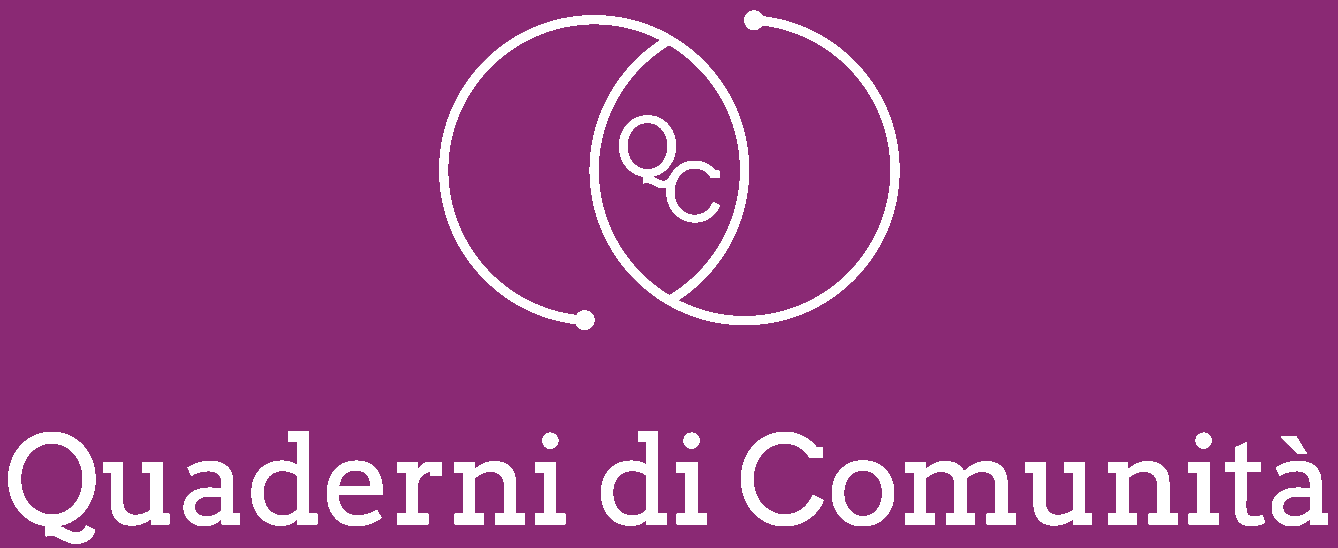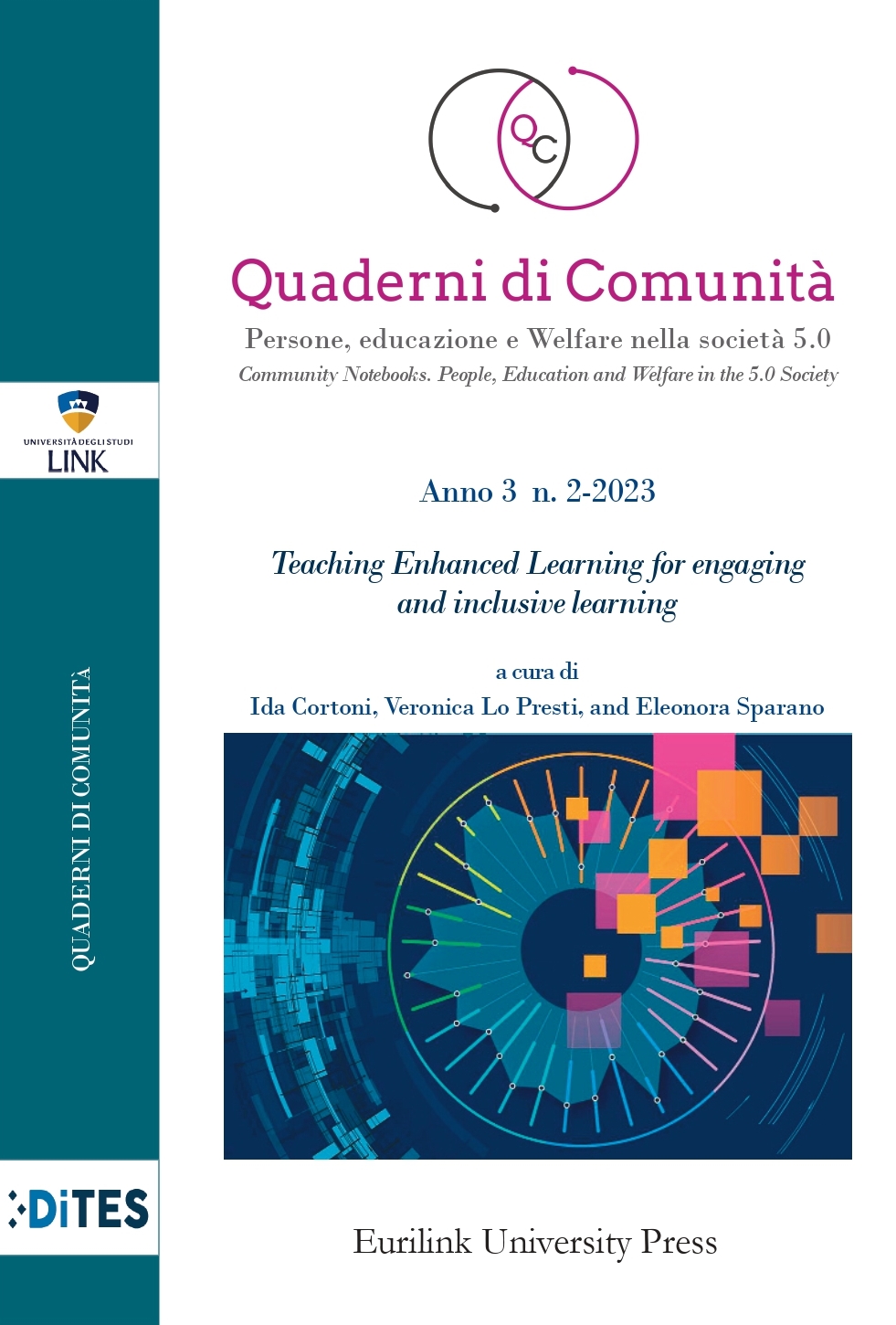The Role of ICT in Learning Processes and University Inclusion
DOI:
https://doi.org/10.61007/QdC.2023.2.127Keywords:
digital inclusion, ict, universal design, barriers , facilitators, students with disabilitiesAbstract
The proposal presents the first outputs of the Universitabile doctoral thesis based on the relationship between educational inclusion (Ainscow and Miles, 2009) and ICT. Using a mixed methods approach, the paper analyses interviews administered to operators of dedicated services, exploring the issue of barriers and facilitation mechanisms during the Covid-19 emergency, presenting technology as an element of exclusion.
References
Adam, A. & Kreps, D. (2009), «Disability and discourses of web accessibility», in Information, Communication and Society, 12, 1041-1058. DOI 10.1080/13691180802552940.
Addeo, F., Catone, M.C. & Parziale, F. (2020), «L’uso delle tecnologie digitali», in C. Lombardo e S. Mauceri (a cura di), La società catastrofica: vita e relazioni sociali ai tempi dell’emergenza Covid-19, Franco Angeli, Milano, 133-151.
Ainscow, M., & Miles, S. (2009), «Developing inclusive education systems: how can we move policies, forward?», in C. Gine (a cura di) La educación inclusiva. De la exclusión a la plena participación de todo el alumnado, Horsori Editorial, Barcellona, 3-11.
Barnard-Brak, L., & Sulak, T. (2010), Online versus face-to-face accommodations among college students with disabilities, in “The American Journal of Distance Education”, 24, 81-91. DOI 10.1080/1357332.2016.1269004.
Berners-Lee, T. (n.d.). W3C Web accessibility initiative. (online). Consultata da http://www.w3.org/WAI.
Bissonnette, L. (2006), Meeting the evolving education needs of faculty in providing access for university students with disabilities, Consultata da http://spectrum.library.concordia.ca/8741.
Bolt, D. & Penketh, C. (2016), Disability, Avoidance and the Academy: Challenging Resistance, Londra, Routledge Taylor Francis Group.
Burgstahler, S. (2015), «Opening Doors or Slamming Them Shut? Online Learning Practices and Students with Disabilities», in Social Inclusion, 3, 6, pp. 69-79.
CE. (2008), Accessibility to ICT Products and services by Disabled and Elderly People. European Commission. Consultata da https://op.europa.eu/s/xAAE.
Cesareni, D. & Pascucci, M. (2011), Pedagogia e scuola, Roma, Carocci editore.
Chiang, E.S. (2019), «Disability cultural centers: How colleges can move beyond access to inclusion», in Disability & Society, 35, 7, pp. 1183-1188. DOI 10.1080/09687599.2019.1679536.
Commissione europea (2021), Strategia sui diritti delle persone con disabilità 2021-2030.
Corbetta, P. (1999), Metodologia e tecniche della ricerca sociale, Bologna, Il Mulino.
Corrao, S. (2000), Il focus group, Milano, Franco Angeli. Dobransky, K. & Hargittai, E. (2006), «The disability divide in internet access and use, in Information», in “Communication and Society”, 9, pp. 313-334. DOI 10.1080/13691180600751298.
Dobransky, K. & Hargittai, E. (2016), «Unrealized Potential: Exploring the Digital Disability Divide», in Poetics, 58, pp. 18-28. DOI 10.1016/j.poetic.2016.08.003.
D.P.C.M. 8 Marzo 2020, Ulteriori disposizioni attuative del decreto- legge 23 febbraio 2020, n. 6, recante misure urgenti in materia di contenimento e gestione dell’emergenza epidemiologica da COVID- 19 (GU Serie Generale n.59 del 08-03-2020).
Di Franco, G. (2011), Tecniche e modelli di analisi multivariata, Milano, Franco Angeli.
Easton, C. (2013), «An examination of the Internet’s development as a disabling environment in the context of the social model of disability and anti-discrimination legislation in the UK and USA, in Universal Access in the Information Society», 12, pp. 105-114. DOI 10.1007/s10209-011-0268-2.
Eurostat (2016b). Disability statistics - prevalence and demographics. Consultata da https://ec.europa.eu/eurostat/statistics-explained/index.php?title=Disability_statistics.
Fasanella, A., Lo Presti, V. & Parziale, F. (2020), «L’esperienza della Didattica a Distanza (DaD)», in C. Lombardo e S. Mauceri (a cura di), La società catastrofica: vita e relazioni sociali ai tempi dell’emergenza Covid-19, Franco Angeli, Milano, 95-116.
Fiocco, P.M. & Martinati, M. (a cura di) (2002), Qualità sociale dei servizi sociali, Milano, Franco Angeli.
Giancola, O., Grimaldi, E. & Romito, M. (2019), «La digitalizzazione della scuola. Temi, teorie e metodi di ricerca», in Scuola Democratica, 10(3), pp. 461-479. DOI 10.12828/95944.
Gladhart, M. A. (2010), «Determining faculty needs for delivering accessible electronically delivered instruction in higher education», in Journal of Postsecondary Education and Disability, 22(3), pp. 185-196. Consultato da https://eric.ed.gov/?id=EJ906692.
Goggin, G. & Newell, C. (2003), Digital disability. The social construction of disability in new media, Oxford, Rowman & Littlefield Publishers.
Grammenos, S. (2015), European comparative data on Europe 2020 & people with disabilities. Centre for European Social and Economic Policy on behalf of the Academic Network of European Disability Experts.Consultata da https://op.europa.eu/s/xAAJ.
Gui, M. (2019), Il digitale a scuola. Rivoluzione o abbaglio?, Bologna, il Mulino.
Hayhoe, S., Roger, K., Eldritch-Boersen, S & Kelland, L. (2015), «Developing inclusive technical capital beyond the Disabled Students’ Allowance in England», in Social Inclusion, 3(6), 29-41. DOI 10.17645/si.v3i6.410.
Kinash, S., Crichton, S., & Kim-Rupnow, W. S. (2004), «A review of 2000−2003 literature at the intersection of online learning and disability», in American Journal of Distance Education, 18(1), pp. 5- 19. DOI 10.1207/s15389286ajde1801_2.
L. n. 104/1992, Legge-quadro per l’assistenza, l’integrazione sociale e i diritti delle persone handicappate (GU Serie Generale n.39 del 17-02-1992 - Suppl. Ordinario n. 30).
L. n. 04/2004, Disposizioni per favorire l’accesso dei soggetti disabili agli strumenti informatici (GU Serie Generale n.13 del 17- 01-2004).
Lombardo, C. & Mauceri, S. (a cura di) (2020), La società catastrofica: vita e relazioni sociali ai tempi dell’emergenza Covid- 19, Milano, Franco Angeli.
Mauceri, S. (2017), «L’avvento dell’era dei mixed methods. Nuovo paradigma o deadline di un dibattito?», in Sociologia e Ricerca Sociale, 113. DOI: 10.3280/SR2017-113002.
Marx, K. (1875), Il capitale. Critica dell’economia politica, edizione italiana, Roma, Newton Compton, 1996.
Macdonald, S.J. e Clayton, J. (2013), «Back to the future, disability and the digital divide», in Disability & Society, 8, 5, pp. 702-718. DOI: 10.1080/09687599.2014.924278.
Merton, R.K. & Kendall, P.L. (1946), «The Focused Interview», in American Journal of Sociology, 51, 541-557 (trad. it. di C. Lombardo, L’intervista focalizzata, Calimera (Le), Kurumuny, 2012).
Moriña, A. e R. L. Gavira (2015), «Hidden voices in higher education: inclusive policies and practices in social science and law classrooms», in International Journal of Inclusive Education, pp.365-378. DOI 10.1080/13603116.2014.935812.
Norris, P. (2001), Digital divide: Civic engagement, information poverty, and the Internet worldwide, Cambridge, University Press.
NTIA. (2013), Exploring the Digital Nation: America’s Emerging Online Experience. Washington, DC: National Telecommunications and Information Administration and Economic and Statistics Administration, US Department of Commerce. Consultata da https://ntia.gov/report/2013/exploring-digital-nation-america-s-emerging-online-experience.
Perez, E. & Thompson, P. (1994), «Natural Hazards: Causes and Effects», in Pre-Hospital Disaster Medicine, 9, 1, pp. 80-88. DOI 10.1017/S1049023X00040917.
Piccone Stella, S. (2003), Esperienze multiculturali, Roma, Carocci editore.
Pitzalis, M., Porcu, M., De Feo, A., & Giambona, F. (2016), Innovare a scuola: insegnanti, studenti e tecnologie digitali, Bologna, il Mulino.
Ragnedda, M., & Muschert, G. W. (2013), The digital divide: The Internet and social inequality in international perspective. London and New York, Routledge.
Ragnedda, M. (2017), The third digital divide: A Weberian approach to digital inequalities, New York, Routledge.
Raising the Floor. (2011). GPII. Consultata da http://gpii.net.
Roberts, J. B., Crittenden, & Crittenden, J. C. (2011), «Students with disabilities and online learning: a cross-institutional study of perceived satisfaction with accessibility compliance and services», in Internet & Higher Education, 14, pp. 242-250. Consultata da https://eric.ed.gov/?id=EJ946504.
Rowland, C., Mariger, H., Siegel, P. M., & Whiting, J. (2010), «Universal design for the digital environment: Transforming the institution», in Educause Review, 45, 6, pp. 14-28. Consultata da https://eric.ed.gov/?id=EJ951246.
Seale, J. K. (2014a), E-learning and disability in higher education: Accessibility research and practice, London, Routledge, Taylor & Francis.
Selwyn, N. (2004), «Reconsidering political and popular understandings of the digital divide», in New Media & Society, 6, 3, pp. 341-362. DOI 10.1177/14614448040425.
Scholz, F., Yalcin, B., & Priestley, M. (2017), «Internet access for disabled people: Understanding socio-relational factors», in Journal of Psychosocial Research on Cyberspace, 11, 1, pp. 2-14. DOI 10.5817/CP2017-1-4.
Tsatsou, P. (2020), «Is digital inclusion fighting disability stigma? Opportunities, barriers, and recommendations», in Disability & Society, 36, 5, pp. 702-729. DOI 10.1080/09687599.2020.1749563.
Università degli Studi “Roma Tre”, Vademecum per promuovere il processo di inclusione delle studentesse e degli studenti con disabilità e con DSA. Consultata da https://www.uniroma3.it/ateneo/uffici/ufficio-studenti-disabilita-dsa/.
Università di Roma “La Sapienza” (2019), Linee Guida per i docenti in favore degli studenti con disabilità e con DSA. Consultata da https://www.uniroma1.it/it/documento/studenti-con-disabilita-e-dsa-linee-guida-i-docenti.
Valentini, E. (2008), Università nella rete-mondo. Modelli teorici e casi di e-learning nelle università straniere, Milano, Franco Angeli.
Van Deursen, A. J., & Van Dijk, J. A. (2014), «The digital divide shifts to differences in usage», in New Media & Society, 16, pp. 507-526. DOI 10.1177/1461444813487959.
Vincente, M. R., & Lopez, A. J. (2010), «A multidimensional analysis of the disability digital divide: Some evidence for Internet use», in The Information Society, 26, pp. 48-64. DOI: 10.1080/ 01615 440903423245.
WAI (n.d.), Web Accessibility Initiative. Consultata da https://w3c.github.io/wai-website/.
Warschauer, M. (2004), Technology and social inclusion: Rethinking the digital divide. Cambridge and London, MIT press.
Downloads
Published
How to Cite
Issue
Section
License
Copyright (c) 2023 Quaderni di comunità

This work is licensed under a Creative Commons Attribution-NonCommercial-NoDerivatives 4.0 International License.







